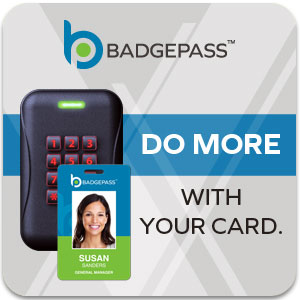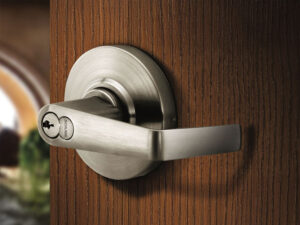Re-posted with permission from BadgePass and edited.
We live in a world where security changes daily and organizations are constantly having to evaluate and improve their security processes. Traditionally, ID badges have been used for just visual identification, but many organizations have started using ID badges for more applications, like door access control or employee time clock. These additional applications and use cases make each card extremely valuable.
The key to a successful ID card system is ensuring your ID badges are properly protected from any attempts at tampering and illegal duplication. Today, anyone with a computer can create a legitimate-looking ID card with ease. That is why many organizations choose to print their ID badges in-house. Not only does it save you money, but you have access to ID badge software that allows you to create an exclusive card design that can be modified as your security needs change. In addition, ID card printers now offer more security features than ever before helping you create lines of defense against counterfeiting, alteration, duplication, and other fraudulent behavior.
Implementing some of these visual security components into your card design will make it easier to identify authentic cards, lessen the risk of duplication, and event protect it during everyday use.
Secure Card Design
A name printed on a plain white card just is not enough anymore. To reduce vulnerability to counterfeit ID cards, your card design should be complex, unique, and visually appealing. You want it to reflect your brand’s image while also enhancing security. The more personable a badge design is, the less likely it is to be copied. A digital photo with at least 300 dpi resolution, fingerprint, or digital signature adds a more personal touch that is unique to each card holder.
Other secure design elements to consider in your card design include watermarks, ghosted images, fine lines, and micro-text. A ghosted image is a semi-transparent copy of the main digital photo on the ID badge that is hard to replicate. The image can be a slightly smaller or larger image embedded in the background with other design elements.
Highly secure credentials typically include design elements that are invisible to the naked eye. Micro-text is a feature that cannot be seen without a magnifying class or with the card system. It is very difficult to replicate so it is used as an added security feature in things like currencies and passports. At first, it looks like a thin line printed on the ID badge, but when examined through a magnifying glass the text presents a phrase or word in very fine print.
With select printer models, customizable text or images can be printed in ultraviolet (UV) ink that can only be seen with a specialty black light. You can also add a fluorescent overlay to your ID’s to create a highly secure credential with logos that can also only be seen with a specific UV light.
Layered Security
Once you have created a unique card design with elements that cannot be fabricated, it is time to decide if you want additional protection or security on your badge. For a lot of organizations, ID badges are used with multiple applications daily, so added protection is necessary to ensure cards last for years to come.
Lamination is a process that adds a clear film to ID cards just after they are printed. It is excellent for both preserving your secure card design and adding durability to the card. Laminated ID cards are protected from things like daily wear and tear, dirt, and water damage.
You can also choose to add holographic laminate to cards as an added security element. Holograms can’t be printed on standard printers and typically contain hard-to-duplicate designs, so they provide an added layer of security. They also make it easier to spot fake or tampered-with cards to allow for quick visual authentication. You can choose to use a standard holographic laminate, or you can incorporate custom 3D designs, logos, and security watermarks. Cards can also be embedded with holographic foil patches for even more security and brand enhancement.
Tactile impression uses a heating process to place a stamp onto the card’s laminate. Many organizations have chosen to incorporate this element for advanced security enhancement of their badge design. Tactile impressions offer a physical element to cards that you can feel, making it easy to verify the authenticity of the card and difficult to duplicate.
Encoding
Adding barcodes, magnetic strips and technology chips to your credential is another way to increase security and add functionality to your ID badge. These encoded ID cards are specially designed to hold and share data.
Barcodes are a widely used feature used for things like tracking, membership and rewards cards, and more. Magnetic stripes are another encoding option you can add to ID cards if you need to store updateable information. They are ideal for use with applications like point of sale as well as time and attendance.
Technology cards (proximity or smart cards) use radio frequency to transfer data, allowing you to use your credential with other applications without the need for a magnetic stripe or barcode reader. Whether you want to use your ID card as a key to access doors or for a multifunctional ID program, technology cards can securely store data and information.
Get Security Features for ID Badges from the ISG
Simply implementing one of these visual security elements makes it drastically more difficult to create a credible duplicate ID badge. Many of these features can be paired together to add even more security to your card. We can help you create the perfect custom card design for your security needs and budget.
The ISG has a nationwide network with more than 90 locations servicing all of the US and Canada. Dealers are certified with a wide variety of solutions from software for ID badges to secure card printers, building access control to video surveillance, asset tracking, time and attendance and a whole lot more.
Contact us today to learn more about the many ISG solutions we offer for creating secure ID badges!

